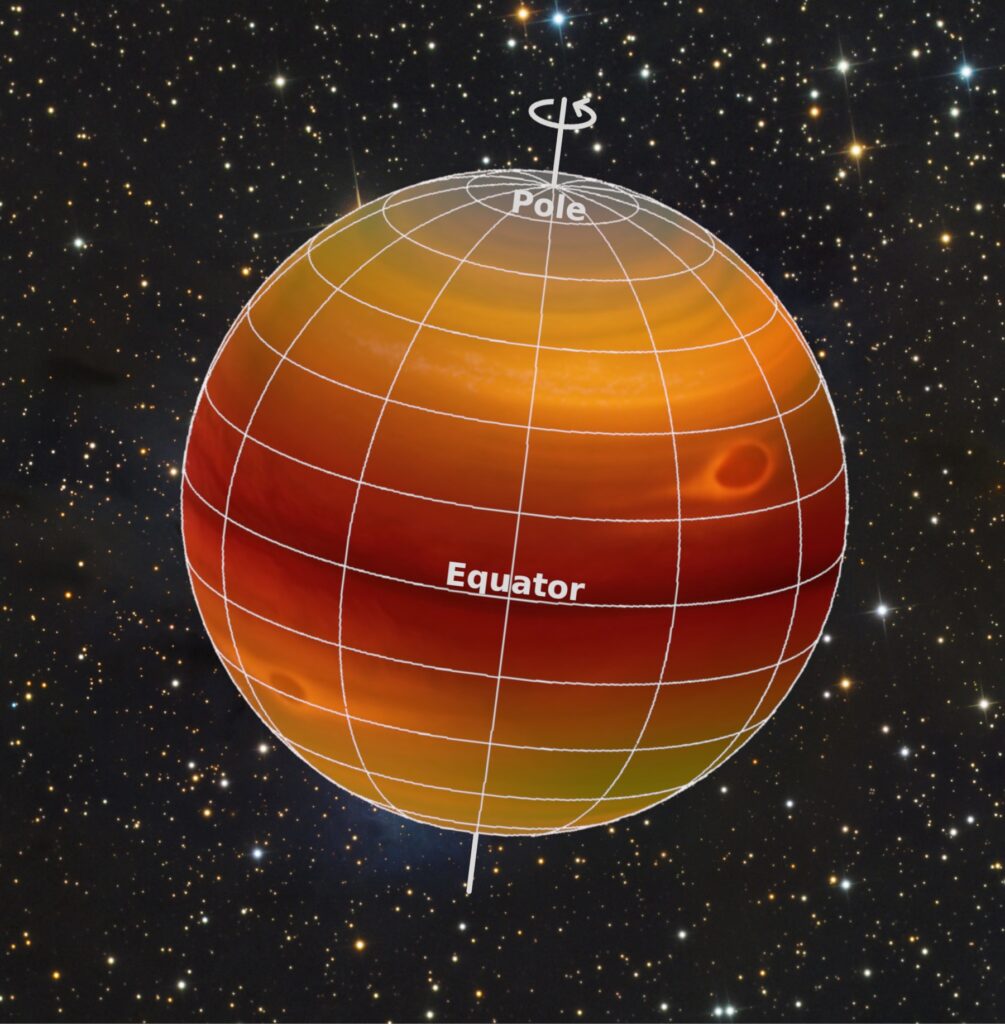
The BDNYC team presented a variety of posters and talks at the 243rd meeting of the American Astronomical Society in New Orleans from January 7th to 11th, 2024. Check out this year’s amazing projects!
POSTERS
Sherelyn Alejandro: Using Gaia Variability to Discover Changing-Look LINER Candidates
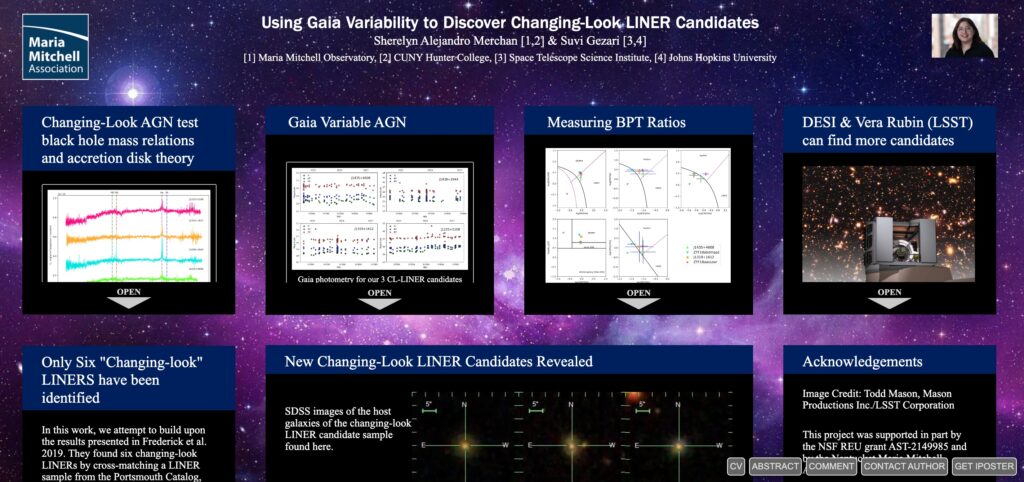
Ally Baldelli: Robustly Quantifying Spectral Doublet Absorption Lines in Brown Dwarfs
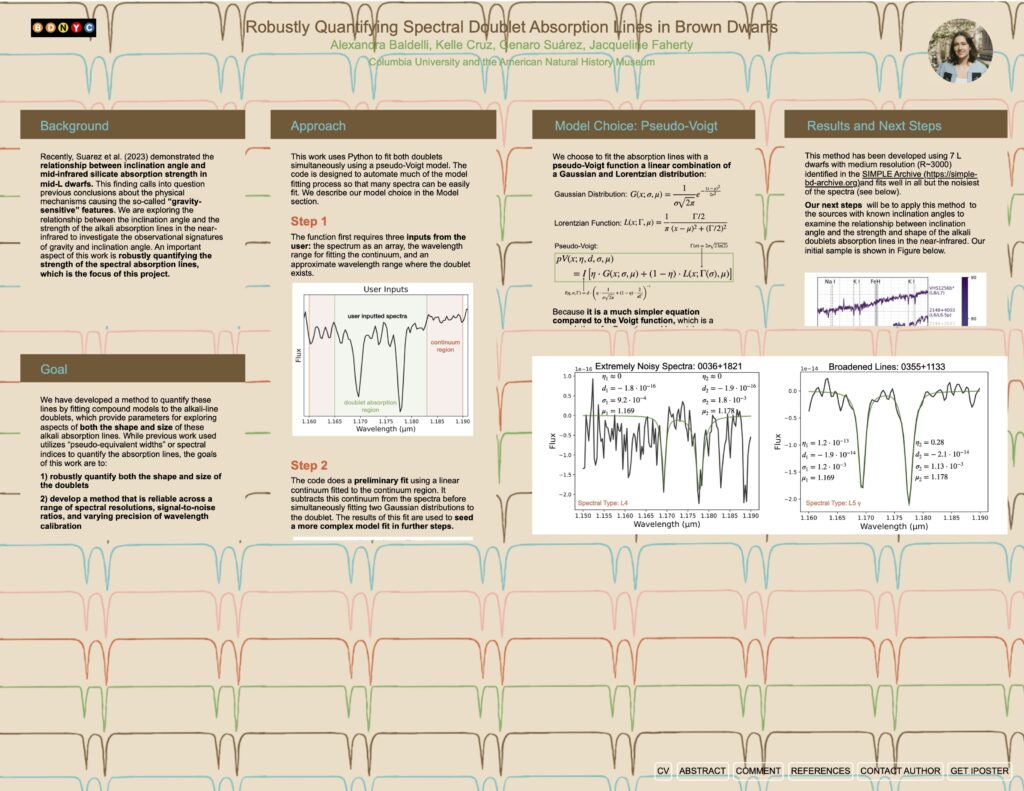
Rosario Cecilio-Flores-Elie: Exploring Mass Ratios in Planetary-Moon Systems: Insights from our Solar System and Beyond

Kelle Cruz: The SIMPLE Archive: A collaboratively-curated database and website of low mass stars, brown dwarfs, and exoplanets
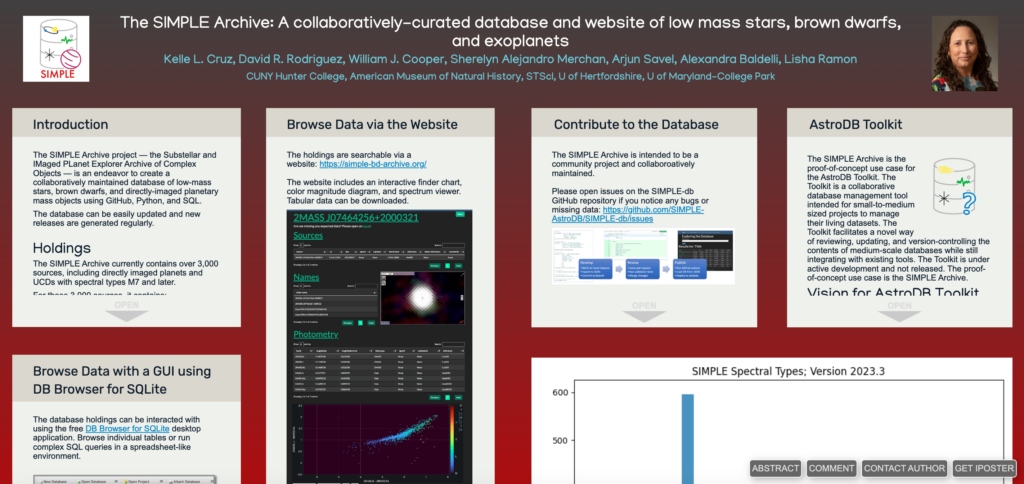
Jackie Faherty: The OpenSpace planetarium software and its impact on visualizing the Known Universe
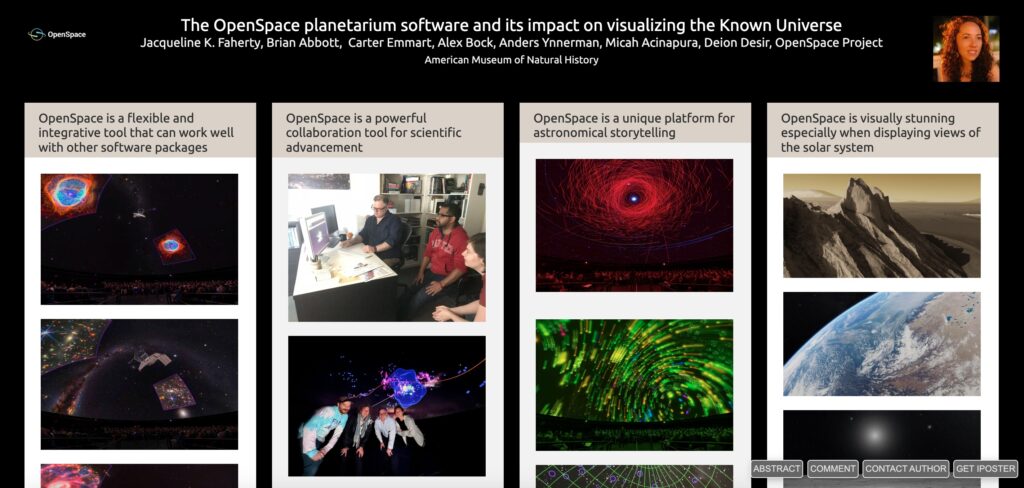
The Masters of Arts in Teaching (MATS) Program at the American Museum of Natural History

Jolie L’Heureux: Revealing Cloudy Substellar Atmospheres with JWST MIRI Synthetic Magnitudes from Spitzer Mid-infrared Spectra
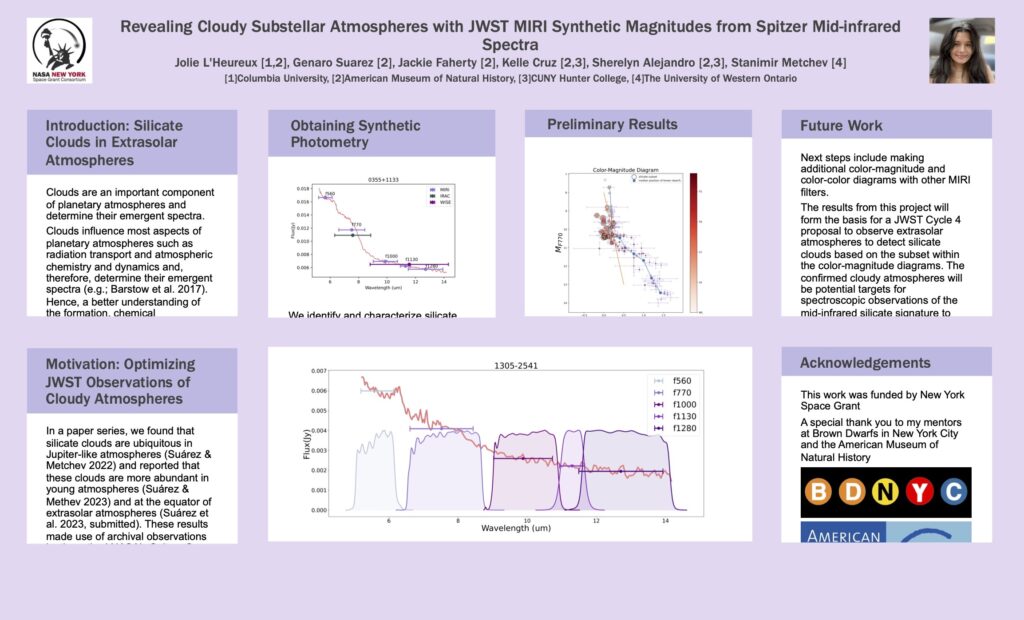
Austin Rothermich: Utilizing Citizen Science to Identify New Ultracool Benchmark Systems

Azul Ruiz Diaz: Investigating the Atmospheric Composition of a Super-Earth

Angela Reji Thomas: Exploring the Phenomenon of Strongly Lensed Gravitational Waves
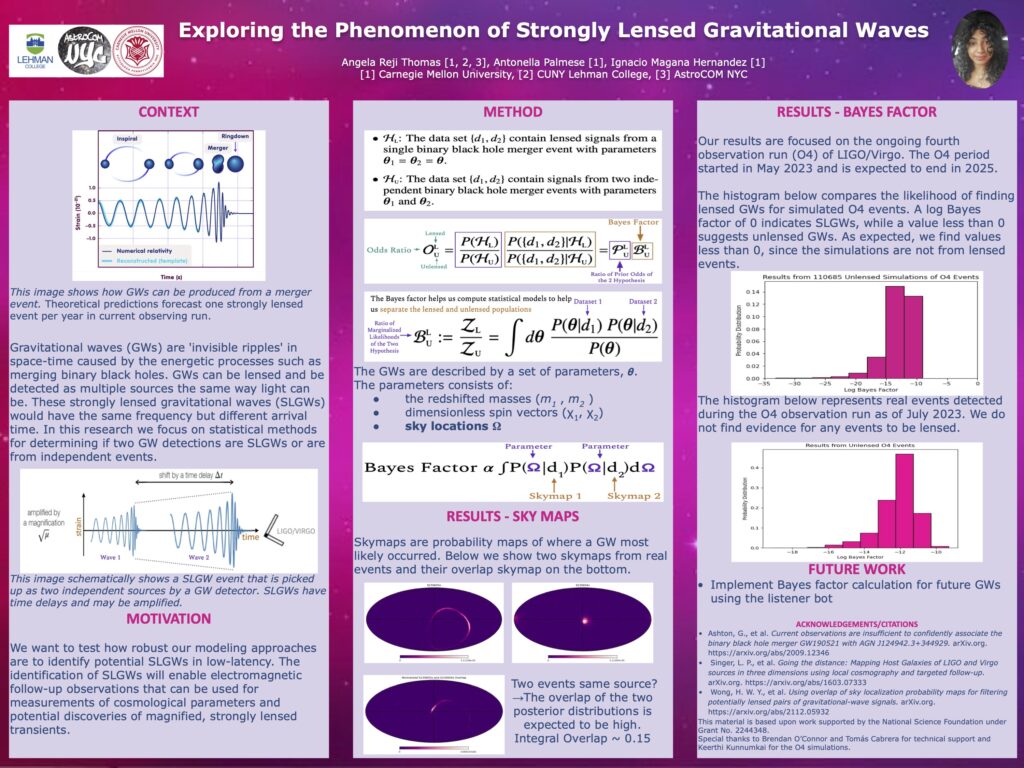
TALKS
Jackie Faherty: NASA’s Webb Finds Signs of Possible Aurorae on Isolated Brown Dwarf
In a AAS press conference and a science talk, Jackie Faherty presented recent research results showing a brown dwarf with infrared emission from methane, likely due to energy in its upper atmosphere. While other brown dwarfs are often found to have stellar wind that contributes to auroral processes, the isolated brown dwarf W1935, found using NASA’s JWST, is cold and lacks a host star, and therefore does not have an obvious source for the upper atmosphere energy. Faherty and her collaborators speculate that the methane emission may be due to processes generating aurorae, such as unaccounted internal processes like the atmospheric phenomena of Jupiter and Saturn, or external interactions with either interstellar plasma or a nearby active moon.
In an additional workshop talk, Jackie Faherty and co-presenter Deion Desir, former Masters in Teaching resident and current sci visualizer, spoke about visualization for scientific advancement and using the OpenSpace software package.
Alejandro Núñez: Chromospheric and Coronal Activity and Its Dependence on Rotation in Praesepe and the Hyades
In a science talk, Alejandro Núñez presented recent research which examines the poorly understood rotation-activity relation of low-mass main-sequence stars which lose angular momentum over time, leading to a decrease in their magnetic activity. Using observations of members of the ≈700 Myr-old Praesepe and Hyades open clusters, Núñez and his collaborators characterized the rotation-activity relation for different tracers of activity at this age. To complement published data, they obtained new optical spectra for 381 stars, new X-ray detections for 28, and new rotation periods for 165. The team used these data to measure the fractional Hα and X-ray luminosities, L_Hα/L_bol and L_X/L_bol, and to calculate Rossby numbers. They reported findings that at ≈700 Myr almost all M dwarfs exhibit Hα emission, with binaries having the same overall color-Hα equivalent width distribution as single stars. In the Rossby-L_Hα/L_bol plane, unsaturated single stars follow a power-law with index β = –5.9±0.8 for Rossby >0.3. In the Rossby-L_X/L_bol plane, the team saw evidence for supersaturation for single stars with Rossby ≤ 0.01, following a power-law with index β_sup = 0.5±0.2, supporting the hypothesis that the coronae of these stars are being centrifugally stripped, and found that the critical Rossby value at which activity saturates is smaller for L_X/L_bol than for L_Hα/L_bol. Finally, Núñez and his collaborators observed an almost 1:1 relation between L_Hα/L_bol and L_X/L_bol, suggesting that both the corona and the chromosphere experience similar magnetic heating.
Mark Popinchalk: Rotation Period Distributions and Light Curve Morphologies of Low Mass Stars and Young Associations
In a dissertation talk, Mark Popinchalk summarized the scope of his PhD research and thesis over the course of six years in 15 minutes, covering almost a semester a minute. Popinchalk highlighted his research on M dwarf rotation periods in relation to H-alpha activity, as well as using rotation periods to explore the age and potential joint history of several young moving groups. The talk included an audio analogy displaying the peculiarity in complex rotator light curves.
As a contributing author to Astrobites, Popinchalk also wrote summaries of several AAS press conferences and daily recaps for the astrophysical literature journal’s website, such as Astrobites at AAS 243: Day 3.
Genaro Suárez: Extrasolar Worlds Exhibit Exotic Sandy Clouds at the Equator
In a AAS press conference and a science talk, Genaro Suárez presented recent research results which found that the silicate absorption feature in mid-infrared spectra informs about the complexity of sandy clouds in extrasolar worlds. Suárez and his collaborators reported a correlation between the amount of clouds, inclination, and near-infrared color of these objects. Their results showed that the equators of extrasolar worlds are cloudier and, therefore, redder than the poles, which indicates that the appearance of extrasolar worlds are highly influenced by their viewing geometry.
